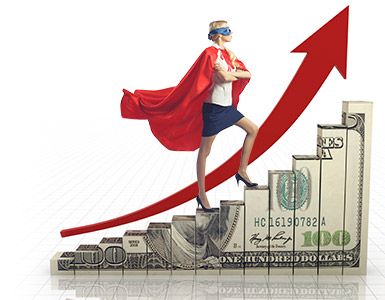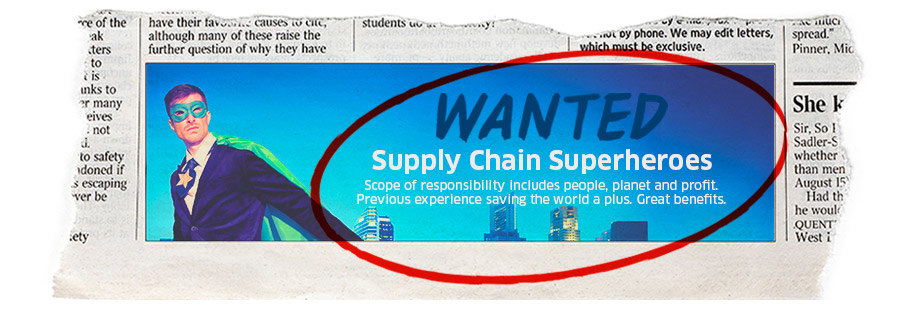CSR gives supply chain pros chance to unleash their inner superheroes
When was the last time you heard a child say that he or she wanted to become a corporate raider or a tyrannical despot when they grow up? No, children, with all their naiveté and enthusiasm, generally aspire to more noble callings: astronaut, doctor, superhero. For all but a lucky few, however, the practicalities of adult life – responsibilities, financial obligations, gravity – often compel more pragmatic career choices. That doesn’t mean that as adults we must abandon our quest to save the world; just that we have to think differently about how we will make our mark.
Once considered an anathema by the likes of economists such as Milt Friedman (“The only social responsibility of business is to increase profits”), businesses today are proving that not only is it possible to do well while doing good, but that taking a “net positive” approach to both social and environmental issues is the key to future business success.
SCM Owns CSR
Furthermore, it is becoming increasingly clear that few professions are better positioned to influence and drive meaningful corporate sustainability efforts as supply chain management. “Supply chain owns sustainability,” according to SCM World Chief Content Officer Kevin O’Marah in the 2015 Future of Supply Chain report.
Few professions are better positioned to influence and drive meaningful corporate sustainability efforts as supply chain management
Stan Aronow, vice president, Supply Chain Research, Gartner also believes supply chain’s role in corporate social responsibility (CSR) deserves more recognition. Aronow reported that Gartner has begun placing more explicit emphasis on CSR in the peer voting and within the Gartner analyst evaluation process for the annual Supply Chain Top 25 rankings.
“Many companies are proud of their CSR initiatives, and have observed that supply chain leadership includes running a responsible, sustainable business, and that our ranking should explicitly reflect this dimension,” wrote Aronow in his 2015 report The 2015 Supply Chain Top 25 Methodology: To Change or Not to Change. “We have always recognized, and often written, that CSR is an important aspect of leadership and wholeheartedly agree that it should be a consideration for how high or low they rate on the annual ranking.”
Follow the Money
To understand how supply chain professionals can help their organizations maximize the impact of their CSR efforts and become more purpose-driven, it is important to recognize how the corporate responsibility and sustainability movements have evolved over the past decade. The road from reactive, compliance-driven CSR to a truly integrated, end-to-end commitment to the triple bottom line – people, planet, and profit – is paved with innumerable examples of how technology companies have contributed to the greater good by supporting various social and environmental causes.
 For example, in his book Changing Business from the Inside Out: A Tree-Hugger’s Guide to Working in Corporations, Tim Mohin, director of corporate responsibility at AMD, recounts an experience from his days as head of supplier responsibility for Apple. Mohin helped Apple set up a classroom within the facilities of one of the company’s Chinese manufacturing partners. The idea was to give the workers the opportunity to improve themselves by taking online courses in their free time. Many, he said, chose to learn English. During a visit to the classroom, the workers “mobbed me with sentiments of thanks,” Mohin wrote. “Their genuine gratitude for the chance to learn a skill that could improve their lives came through loud and clear.”
For example, in his book Changing Business from the Inside Out: A Tree-Hugger’s Guide to Working in Corporations, Tim Mohin, director of corporate responsibility at AMD, recounts an experience from his days as head of supplier responsibility for Apple. Mohin helped Apple set up a classroom within the facilities of one of the company’s Chinese manufacturing partners. The idea was to give the workers the opportunity to improve themselves by taking online courses in their free time. Many, he said, chose to learn English. During a visit to the classroom, the workers “mobbed me with sentiments of thanks,” Mohin wrote. “Their genuine gratitude for the chance to learn a skill that could improve their lives came through loud and clear.”
Purpose-driven companies: make more money, have more engaged employees, have more loyal customers, and are better at innovation and transformational change
Stories like these may pull at the heartstrings, but, at the end of the day, business is traditionally about the purse strings. This is why CSR has remained largely peripheral in many organizations. Today, however, there is mounting evidence that integrating social, ethical, and environmental considerations into the core business strategy “is not something that will cost your business, but something that will enhance your business,” according to Michael Beer, Cahners-Rabb Professor of Business Administration, Emeritus, at Harvard Business School and a director of the Center for Higher Ambition Leadership.
In 2015, Harvard conducted a survey sponsored by the EY Beacon Institute to determine how and why companies are employing purpose to position their organizations for success in the global market. The survey found that purpose-driven companies: make more money, have more engaged employees, have more loyal customers and are better at innovation and transformational change. “It seems to be easier to win the game when you care about the game,” concluded the survey report, The Business Case for Purpose.
Capes are Optional
 So, you’re ready to join the CSR crusade and claim your calling as a supply chain superhero, but where do you start? Mark Horoszowski, co-founder and CEO of MovingWorlds.org, a global platform that helps people volunteer their skills around the world, offered this advice in a recent blog: “Pilot more initiatives aligned with core business outcomes.” CSR initiatives, he wrote, “scale or die based on their ability to drive business outcomes. Don’t do what you think is most interesting, instead, do what will actually make a positive difference to your business and to the world.”
So, you’re ready to join the CSR crusade and claim your calling as a supply chain superhero, but where do you start? Mark Horoszowski, co-founder and CEO of MovingWorlds.org, a global platform that helps people volunteer their skills around the world, offered this advice in a recent blog: “Pilot more initiatives aligned with core business outcomes.” CSR initiatives, he wrote, “scale or die based on their ability to drive business outcomes. Don’t do what you think is most interesting, instead, do what will actually make a positive difference to your business and to the world.”
Don’t do what you think is most interesting, instead do what will actually make a positive difference to your business and to the world
For more inspiration, here are a few examples of how leading tech companies have leveraged their corporate power and supply chain resources to build social, economic and/or environmental value.
The Syrian refugee crisis raised global awareness of the tragically high number of forcibly displaced people there are worldwide, but this issue isn’t news to Ericsson. Since 2010, Ericsson has been working with Refugees United, also known as REFUNITE, an online family reconnection platform that helps displaced people search for family members from whom they have been separated either due conflict, natural disaster or other uprooting factors. Ericsson assisted REFUNITE in expanding their program to include a mobile application. They also provide REFUNITE with technical expertise and engage with mobile network operators and employees for on-the-ground support. Refugees United reports there are currently about 400,000 profiles on the platform.
Sharp Corp. Closed-loop Water Recycling System
As part of its vision for a sustainable, recycling-based society, Sharp has adopted a closed-loop water recycling system to repeatedly recycle the large amount of water used for the production of LCDs at its Mie Plant (Taki District, Mie Prefecture, Japan) and Kameyama Plant (Kameyama, Mie Prefecture). At both plants, the water used in the production process goes through steps such as biofiltration, microfiltration, and reverse osmosis. The purity of the resulting water is the same as or even better than that of industrial-use water. In 2014, Sharp reported that nearly 100 percent of the water discharged from the production process was recycled and reused.
Deutsche Telekom Labor Relations Benchmark Database
Turnover rates among low-skilled workers in China can range from 30-40 percent annually, leading to increased HR management and training costs and greater quality control issues. DT instituted a best practices benchmark database to demonstrate to its suppliers in China that adherence to Chinese labor law in terms of working hours, and working and living conditions can create a competitive advantage. The effort resulted in a 30 percent increase in the number staff returning to work after Chinese New Year (55 percent return rate in 2012 compared to 85 percent in 2013). Efficiency gains from increased productivity included an additional 500,000 units produced in the first two months after Chinese New Year in 2013 vs. 2012, by the same supplier workforce size. Reduced defect rates and a 43 percent reduction in workplace injuries were also reported.
Here’s a preview of some of the CSR insights and best practices shared in this section by sustainability advocates and supply chain thought leaders:
- Frédéric Trinel, co-CEO, EcoVadis, Driving Supplier CSR Performance in a Digital World: “Traditional compliance approaches are often based on one-off audits. Digital technologies enable real-time monitoring of performance and measure ongoing progress on key sustainability indicators.”
- Amanda West, co-founder, EcoZoom, The Best of Both Worlds: B Corps Find Sweet Spot Between Doing Well and Doing Good: “As a social enterprise, our goal is to take
the for-profit model into a space that is dominated by government agencies, aid organizations and NGOs.”
Related Resources
- Presentation: Sustainability Assessment Standard Framework (SASF) for the global ICT industry, 2015 Stakeholder Update
- Report: Servants of Servers – Rights violations and forced labour in the supply chain of ICT equipment in European universities
- Blog: RCOI, A Critical Step in Conflict Minerals Compliance
- Blog: European Chemical Agency Adds Five Substances to the Candidate List
- Article: What Does It Mean To Be a Truly Diverse Company?
- Article: The COP21 Climate Agreement: What Does It Mean for the United States?
- Website: UN Sustainable Development Goals
- Corporate Citizenship Blog: Want To Achieve Corporate Citizenship Progress? Include Your Supply Chain
